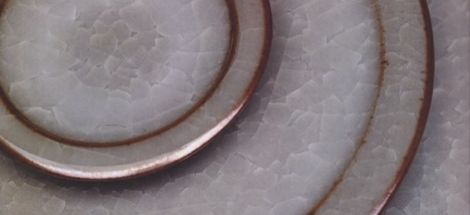Chün or Jün glazes
are opalescent bluish stoneware or porcelain glazes originating in Song Dynasty, China. These high fire glazes are typically fired to Cone 8 or 10. Their color is primarily an optical illusion stemming from light refracted off the inside of bubbles trapped in the glaze. The glazes are usually high in silica. The color comes from small percentages of iron often enhanced with minute amounts of copper.

https://ceramicartsnetwork.org/daily/ceramic-glaze-recipes/high-fire-glaze-recipes/the-beautiful-variations-of-chun-glazes/
Тенмоку
( 天目, так же произносится как "теммоку" или "темоку" ) — это темная глазурь, по виду похожая на нефтяные пятна, встречается в китайской и японской керамике.
http://yanatpottery.blogspot.ru/2015/11/blog-post_26.html

Снежное кракле
"Я обратил внимание на эту глазурь в сувенирной лавке в музее лет пятнадцать назад. Она была нанесена на небольшую бутылочку из набора для сакэ, уложенного в традиционную японскую деревянную коробку. Это была прекрасная кракле глазурь, но не такая, которая бывает в раку. У нее были раковистые трещины, похожие на повалившуюся стопку книг.


http://community.ceramicartsdaily.org/topic/3762-nuka-glaze-what-is-it/
are opalescent bluish stoneware or porcelain glazes originating in Song Dynasty, China. These high fire glazes are typically fired to Cone 8 or 10. Their color is primarily an optical illusion stemming from light refracted off the inside of bubbles trapped in the glaze. The glazes are usually high in silica. The color comes from small percentages of iron often enhanced with minute amounts of copper.

https://ceramicartsnetwork.org/daily/ceramic-glaze-recipes/high-fire-glaze-recipes/the-beautiful-variations-of-chun-glazes/
Тенмоку
( 天目, так же произносится как "теммоку" или "темоку" ) — это темная глазурь, по виду похожая на нефтяные пятна, встречается в китайской и японской керамике.
http://yanatpottery.blogspot.ru/2015/11/blog-post_26.html

Снежное кракле
"Я обратил внимание на эту глазурь в сувенирной лавке в музее лет пятнадцать назад. Она была нанесена на небольшую бутылочку из набора для сакэ, уложенного в традиционную японскую деревянную коробку. Это была прекрасная кракле глазурь, но не такая, которая бывает в раку. У нее были раковистые трещины, похожие на повалившуюся стопку книг.
Позже я узнал, что это - «Снежное кракле». Глазурь эта на самом деле имеет много названий («Снежное кракле», «Рыбья чешуя», «Ледяное кракле», «Панцирь черепахи»), что, собственно, является отражением того, что больше нравится людям.
Независимо от того, как ее называть, эта трещиноватая глазурь наносится таким толстым слоем, что трещины расходятся не только вертикально, но и горизонтально. Сетка трещин может быть большой или мелкой, и они имеют отчетливую шестигранную форму. Легко понять, почему кракле называют «Панцирь черепахи», когда сетка крупная."
https://portalkeramiki.ru/index.php/from-the-world/209-snezhnoe-krakle
Nuka glaze

Writing from NCECA.....working totally from memory here.... my glaze file is not here.
"Nuka" is the Japanese word for the husk (or hull) of the rice kernel. It is a by-product of the milling of white rice. The Japanese version is from a short grain rice.
Potter parlance (in Japanese) uses this term for glazes based upon rice HUSK ash (not rice straw ash....... different chemical composition). The agricultural waste is piled in the fields and is then burned. The piles smolder more than burn, and a good ash for glaze use is actually dark grey to black. You don't want it to burn cleanly. This color comes from carbon residue in the ash. SO the ash has a high L.O.I. The chemical composition of rice husk ash (after L.O.I.) is almost colloidally fine silica. (TJR I'd call it more of a semi-gloss.)
Nuka glazes are high calcium fluxed glazes (from the washed wood ash) what use the rice husk ash for a lot of the silica content, and bringing in the silica in a very fine particle size. They fire a bluish white and are slightly milky opaque where thicker due to the unmelted silica particles.
I use real rice husk ash (imported and expensive) and washed hardwood ash. Firing it from Orton cone 10 to Orton cone 14. The recipe I started with I got from Hamada Shoji-sensei.
1/3 rice husk ash
1/3 wood ash
1/3 terayama stone ( a high silica bearing feldspathoid)
That is modified for more locally available materials as...............
32% rice husk ash
32% wood ash
32% Custer feldspar
4% flint
This stuff is natural material glaze.... the slurry handles VERY differently from what most people are used to when ucing commercial beneficiated materials. It looks REALLY thick when on the proper consistency, and is sort of "fuzzy" looking. It setles down in firing due to the high L.O.I. of the rice husk ash.
Комментариев нет:
Отправить комментарий